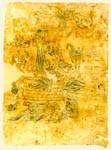|
|
| Anthivola |
17th c. Dionysiou Monastery Drawing on paper, 42 x 30.2 cm |
|

|
This sketch illustrates the ninth chapter of Revelation (verses 1-11), according to which 'And the fifth angel sounded, and I saw a star fall from heaven to earth; and to him was given the key of the bottomless pit. And he opened the bottomless pit; and there arose a smoke out of the pit, as the smoke of a great furnace, and the sun and the air were darkened by reason of the smoke of the pit. And there came out of the smoke locusts upon the earth,...' In the centre of the picture is a circular wall representing the bottomless pit, and round this move the figures described in the passage from Revelation. At the top an angel flies through clouds blowing a trumpet, while farther down are the locusts, the smoke with the star (Dionysios of Fourna 1909, p. 132) and the living and the dead. The locusts are rendered with female faces 'and on their heads were as it were crowns of gold... and they had hair as the hair of women... and they had tails like scorpions, and there were stings in their tails.....' This scene, known from Athonite wall-paintings of the Revelation in both the Monastery of Dionysiou and the Monastery of Docheiariou (Tavlakis 1995, p. 21), follows the instructions in the Painter's Manual almost word for word. A distinctive feature of this anthivolon (painting cartoon) is that the figures on the right are for no apparent reason not drawn below the waist. This feature also exists in both the Dionysiou and the Docheiariou frescoes (Huber 1995, pp. 154-5, figs. 148-9), but there the reason is clear, the artist having run out of space. The repetition of this feature in the anthivolon leads to its direct association with the wall-paintings. It has been established that Byzantine artists did not illustrate the text of the Revelation, and the earliest representation painted for Greek Orthodox people cannot be dated earlier than the late sixteenth century (Chatzidakis 1995 (2), p. 16). This anthivolon from Dionysiou Monastery can probably be dated to the seventeenth century, contemporary that is with the earliest surviving Athonite representations of the Revelation. Its relation with the frescoes decorating the exterior of the monastery's refectory - a model-copy relation - is obvious in every detail. It may even have been a copy used by the monastery's own painters, as it was discovered, recently, among other anthivola that seem to have belonged to these artists.
| |
|
Bibliography: Unpublished.
| ||
| I.T. | ||
| Index of exhibits of Monastery of Dionysiou 17th century |
||
Reference address : https://www.elpenor.org/athos/en/e218ac3.asp